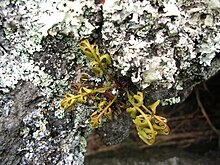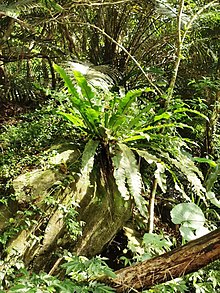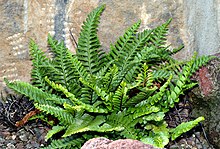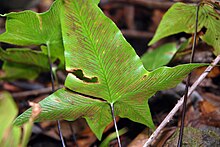Asplenium
| Asplenium | |
|---|---|

| |
| Maidenhair spleenwort (Asplenium trichomanes ssp. quadrivalens) | |
| Scientific classification | |
| Kingdom: | Plantae |
| Clade: | Tracheophytes |
| Division: | Polypodiophyta |
| Class: | Polypodiopsida |
| Order: | Polypodiales |
| Suborder: | Aspleniineae |
| Family: | Aspleniaceae |
| Genus: | Asplenium L. |
| Type species | |
| Asplenium marinum | |
| Species | |
|
About 700, but see text. | |
| Synonyms | |
and see text | |
Asplenium is a
The most common vernacular name is spleenworts, applied to the more "typical" species. A. nidus and several similar species are called bird's-nest ferns, the Camptosorus group is known as walking ferns, and distinct names are applied to some other particularly well-known species.
Taxonomy and genetics
Many groups of species have been separated from Asplenium as segregate genera. These include Camptosorus, Ceterach, Phyllitis, and Tarachia, but these species can form hybrids with other Asplenium species and because of this are usually included in a more broadly defined Asplenium.[1]
Some of the older classifications elevate the Aspleniaceae to the taxonomic rank of order as Aspleniales. The newer classifications place it in the subordinal group called eupolypods within the order Polypodiales. Within the eupolypods, Aspleniaceae belongs to a clade informally and provisionally known as eupolypods II.
It has been found that in some species, the
Uses
Both the scientific name and the common name "spleenwort" are derived from an old belief, based on the
Vitruvius relates the story of the name thus:
... certain pastures in Crete, on each side of the river Pothereus, which separates the two Cretan states of Gnosus and Gortyna. There are cattle at pasture on the right and left banks of that river, but while the cattle that feed near Gnosus have the usual spleen, those on the other side near Gortyna have no perceptible spleen. On investigating the subject, physicians discovered on this side a kind of herb which the cattle chew and thus make their spleen small. The herb is therefore gathered and used as a medicine for the cure of splenetic people. The Cretans call it ἄσπληνον. . Ten Books on Architecture – via Wikisource.
A few of these ferns have some economic importance in the
Asplenium species are used as food plants by the
Selected species





- black spleenwort(= A. lucidum Burm.f.)
- Asplenium adiantum-nigrum ssp. adiantum-nigrum
- Asplenium adiantum-nigrum ssp. serpentini (Tausch) Koch
- Asplenium adulterinum Milde – ladder spleenwort
- Asplenium aequibasis
- Asplenium aethiopicum
- Asplenium africanum
- Asplenium × alternifolium Wulf.
- Asplenium anceps
- Asplenium angustum Sw.
- Asplenium antiquum Makino
- Asplenium ascensionis S.Watson
- Asplenium attenuatum R.Br.
- Asplenium aureum (sometimes in Ceterach)
- Asplenium auritum
- crow's-nest fern
- Asplenium australasicum f. australasicum
- Asplenium australasicum f. robinsonii
- Asplenium azoricum Lovis, Rasbach & Reichst.
- Asplenium bifrons
- Asplenium billottii – lanceolate spleenwort
- Asplenium bipinnatifidum
- Asplenium brachycarpum
- Asplenium bradleyi
- mother spleenwort, hen and chickens fern, mouku (Māori)
- Asplenium carnarvonense - Brownsey
- Asplenium caudatum
- rustyback fern(sometimes in Ceterach)
- Asplenium chathamense Brownsey
- Asplenium chihuahuense Baker
- Asplenium compressum Sw.
- Asplenium congestum
- Asplenium corderoanum
- Asplenium crinicaule
- Asplenium cristatum
- Asplenium cuneifolium Viv. (= A. forsteri auct. non Sadl.) – serpentine spleenwort
- Asplenium cymbifolium
- Asplenium daghestanicum H.Christ – Dagestanian spleenwort
- Asplenium dalhousiae (sometimes in Ceterach)
- Asplenium dareoides
- Mauritius spleenwort
- Asplenium difforme R.Br.
- Asplenium fissum
- Norfolk Island Spleenwort
- Asplenium divaricatum
- Asplenium dregeanum
- Asplenium × ebenoides R.R.Scott
- Asplenium ecuadorense Stolze
- Asplenium feei Kunze ex Fée
- Asplenium fissum
- Asplenium flabellifolium – necklace fern
- hanging spleenwort
- smooth rock spleenwort
- Asplenium forisiense – rock spleenwort
- Asplenium formosum
- Asplenium gemmiferum Schrad.
- Asplenium × germanicum
- Asplenium gueinzii Mett.
- Asplenium goudeyi Lord Howe Island
- Asplenium haughtonii – Barn Fern
- Asplenium hemionitis
- Asplenium hermannii-christii Fomin – Hermann Christ's asplenium
- Asplenium hookerianum Colenso
- Asplenium hybridum
- Asplenium incisum
- Asplenium × jacksonii Alston – Jackson's spleenwort (sterile, triploid hybrid between Asplenium adiantum-nigrum and Asplenium scolopendrium)[4]
- Asplenium × kenzoi - oni-hinokishida,[5] cultivated in Japan[6]
- Asplenium komarovii - Akasawa[7]
- Asplenium laciniatum
- Asplenium lamprophyllum Carse
- Asplenium laserpitiifolium – Johnston River fern
- Asplenium lepidum C.Presl
- Christmas Island spleenwort
- Asplenium longissimum
- Asplenium lucidum
- Asplenium lunulatum – Hen-and-chicks
- Asplenium lyallii
- Asplenium macedonicum[8]
- Asplenium majoricum
- Asplenium marinum – sea spleenwort
- Asplenium × microdon T Moore – Moore's spleenwort (hybrid between Asplenium scolopendrium and Asplenium obovatum subsp lanceolatum)
- Asplenium milnei Carruth
- mountain spleenwort
- Asplenium musifolium
- Asplenium nidus – bird's-nest fern
- Asplenium normale
- Asplenium obliquum
- shining spleenwort(= A. lucidum auct. non Burm.f., sensu G.Forst.)
- Asplenium obovatum
- Asplenium obtusatum G.Forst.
- Asplenium obtusatum ssp. northlandicum (Brownsey) Ogle (possibly distinct species)
- Asplenium obtusatum 'Chile' (possibly distinct species, sometimes included in A. obliquum)
- Asplenium oligolepidum C.Chr. (= A. lucidum auct. non Burm.f., sensu G.Forst.)
- Asplenium oligophlebium
- Irish spleenwort(sometimes included in A. adiantum-nigrum)
- Asplenium pacificum
- Asplenium paleaceum R.Br. – chaffy spleenwort
- Asplenium palmeri
- Asplenium parvum
- Asplenium petrarchae
- lobed spleenwort
- Asplenium planicaule
- Asplenium platybasis Kunze ex Mett.
- ebony spleenwort
- sickle spleenwort
- Asplenium praemorsum
- Asplenium prolongatum Hook.
- Asplenium pteridoides Baker
- black-stemmed spleenwort
- American walking fern(sometimes in Camptosorus)
- Asplenium richardii
- Asian walking fern(sometimes in Camptosorus)
- wall-rue
- Asplenium rutifolium
- Asplenium sagittatum – Mule's spleenwort (sometimes in Phyllitis)
- Asplenium sandersonii Hook.
- Asplenium × sarniense Sleep Guernsey Spleenwort
- Asplenium schizotrichum Copel.
- Asplenium schweinfurthii
- Asplenium scleroprium
- hart's-tongue fern(sometimes in Phyllitis)
- Asplenium scolopendrium var. americanum – American Hart's-tongue
- Asplenium seelosii
- forked spleenwort, northern spleenwort
- Asplenium septentrionale × trichomanes Wulf.
- Asplenium serra
- wild bird's-nest fern
- Asplenium sessilifolium
- Asplenium shuttleworthianum Kunze
- Asplenium simplicifrons F.Muell.
- Asplenium splendens
- Asplenium surrogatum P.S.Green
- Asplenium tenerum G.Forst.
- Asplenium terrestre
- Asplenium theciferum (Kunth) Mett.
- Asplenium thunbergii
- maidenhair spleenwort
- Asplenium trichomanes ssp. quadrivalens D.E. Meyer
- Asplenium trichomanes ssp. trichomanes
- Asplenium trichomanes subsp. coriaceifolium
- Asplenium trilobum Cav.
- Asplenium tutwilerae B.R.Keener & L.J.Davenport
- Asplenium vespertinum
- Asplenium vieillardii Mett.
- Asplenium virens
- green spleenwort
- Asplenium vittiforme
- Asplenium viviparum
See also
- Mount Asplenium
- Phyllocladus aspleniifolius (Celery-top Pine, a conifer with Asplenium-like leaves)
- Asplenium hybrids
References
Asplenium.
- S2CID 85868809.
- PMID 18462954.
- ^ ISBN 0709051069.
- ISBN 978-1-902864-07-5.
- ^ "Asplenium × kenzoi". Germplasm Resources Information Network. Agricultural Research Service, United States Department of Agriculture. Retrieved December 15, 2017.
- JSTOR 1547233.
- ^ "Asplenium komarovii Akasawa | Plants of the World Online | Kew Science".
- ^ "The list of plant and animal species for which the status of natural rarities was established". Archived from the original on August 7, 2011. Retrieved August 26, 2010.
